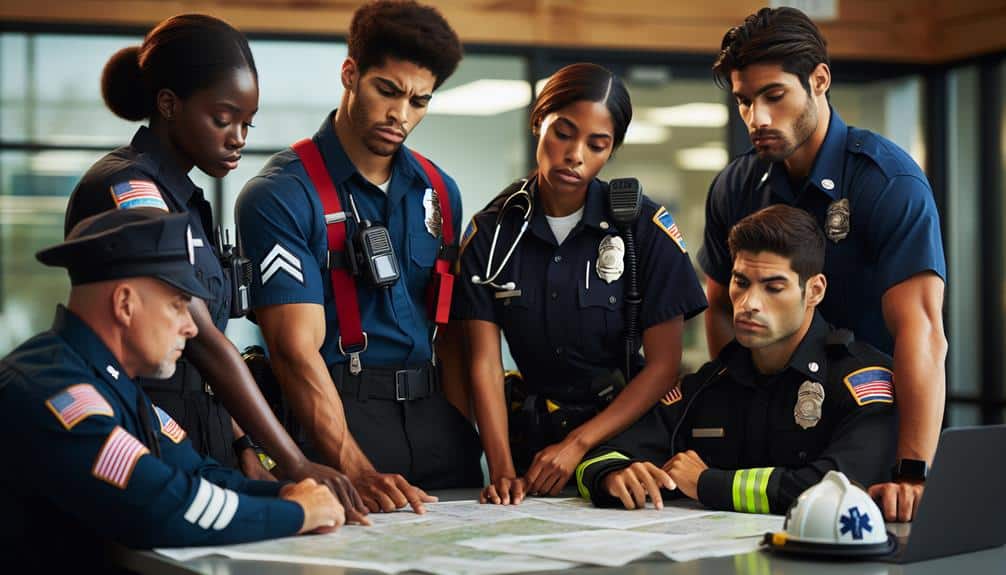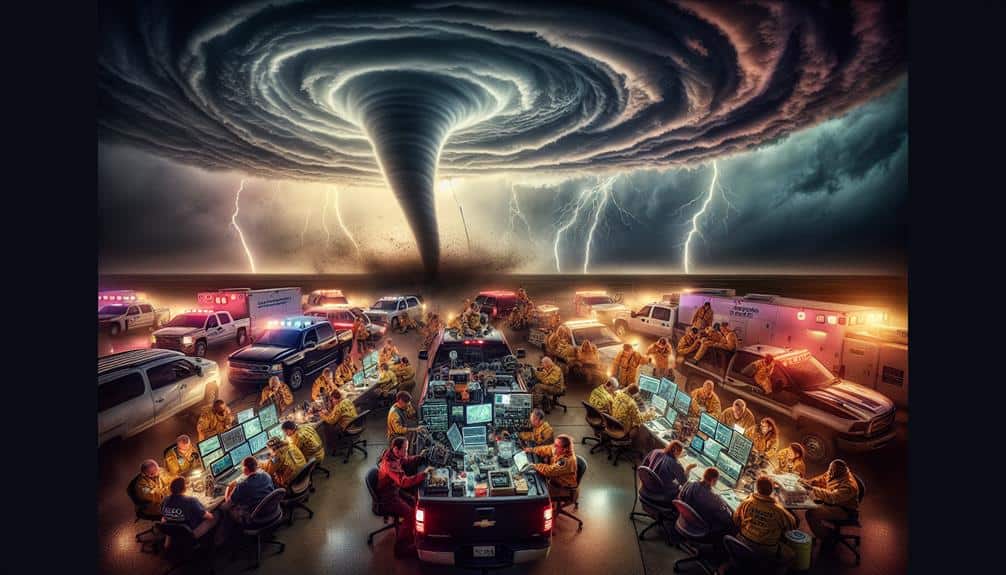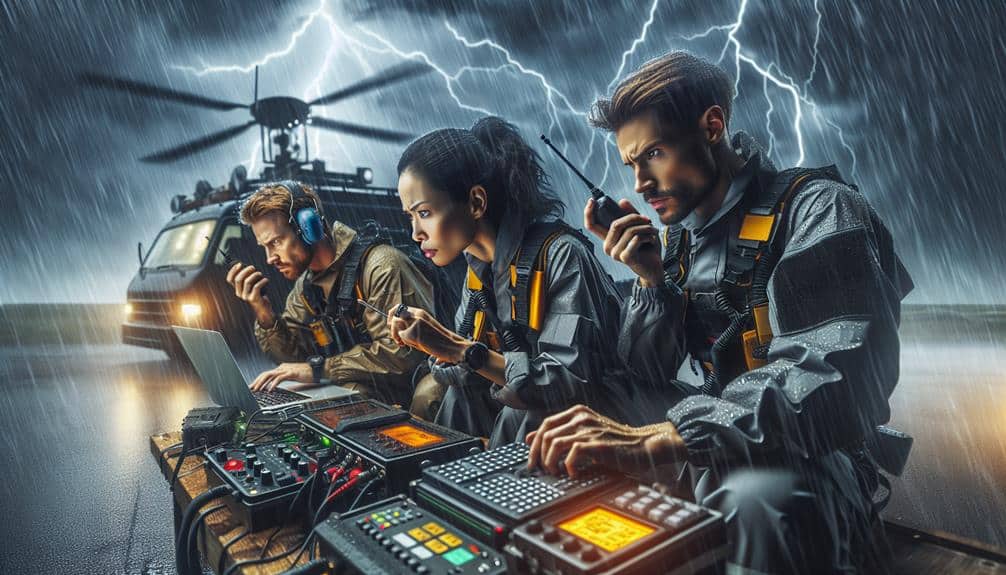In emergency situations, coordinating with first responders effectively depends on strong communication channels and clear protocols. We need to ensure our communication systems are robust and regularly tested, utilizing multiple channels to avoid single points of failure. Familiarizing ourselves with emergency protocols and practicing them regularly assures swift, organized responses. Sharing real-time data, like live feeds and GPS tracking, enhances decision-making. Establishing a unified command structure and fostering collaboration is vital during rescue operations. Post-emergency, immediate debriefing helps us improve and supports our team's well-being. By following these steps, we can notably enhance our emergency response efficiency. Discover how each step interconnects to save lives.
Key Points
- Establish direct communication lines with first responders for real-time updates and rapid coordination.
- Use multiple communication channels to prevent single points of failure and ensure continuous information flow.
- Implement a unified command structure to streamline decision-making and resource allocation.
- Conduct regular drills to familiarize all teams with emergency protocols and communication tools.
Establishing Communication Channels
In an emergency, we must quickly establish clear and dependable communication channels with first responders to guarantee effective coordination. When seconds count, our ability to communicate efficiently can mean the difference between chaos and control. We need to make certain that our emergency communication systems are robust and tested regularly to maintain their reliability. This includes having multiple channels, such as radio, mobile, and internet-based systems, to prevent single points of failure.
First responders rely on timely and accurate information to make life-saving decisions. We should prioritize direct lines of communication to fire departments, police, and medical teams, making sure that they receive real-time updates. By setting up a centralized communication hub, we can streamline the flow of information and minimize the risk of miscommunication.
We must also train our teams to use these communication tools effectively. Regular drills and exercises can help us identify potential weaknesses in our systems and address them proactively. By fostering a culture of preparedness and vigilance, we empower ourselves and our communities to respond more effectively in emergencies.
Understanding Emergency Protocols
Understanding emergency procedures is fundamental for guaranteeing a swift and organized response during a crisis. When an emergency strikes, knowing exactly what to do and when to do it can save lives and mitigate damage. That's why protocol training is vital for everyone involved in emergency response efforts.
We need to familiarize ourselves with the specific procedures that have been developed for various types of emergencies. These protocols outline the steps to take, the roles and responsibilities of each responder, and the communication methods to use. By adhering to established guidelines, we can avoid confusion and make sure that everyone is working towards the same goal.
Protocol training isn't a one-time event. It requires regular updates and practice to stay current with evolving best practices and new threats. Drills and simulations help us internalize these procedures, making our responses more automatic and effective when real emergencies occur.
In addition, understanding emergency procedures empowers us to act confidently and independently while still coordinating seamlessly with first responders. This balance between autonomy and coordination is key to preserving our freedom and safety. By mastering these protocols, we can contribute to a more resilient and responsive emergency management system.
Sharing Real-Time Data
Equipped with a solid understanding of emergency protocols, we must now focus on sharing real-time data to enhance our collective response efforts. Effective data sharing guarantees that all involved parties have access to the same critical information, enabling us to make informed decisions quickly and efficiently.
To optimize our communication protocols, we should implement the following key strategies:
- Utilize Unified Communication Platforms: Adopting a standardized platform for data sharing allows us to streamline information flow and reduce the chances of miscommunication.
- Real-Time Updates: Regularly updating everyone with the latest information can significantly improve our response time. This includes live feeds, GPS tracking, and instant alerts.
- Data Encryption: To maintain the integrity and confidentiality of shared data, we must employ robust encryption methods. This prevents unauthorized access and guarantees that sensitive information remains secure.
- Interagency Coordination: Establishing clear communication protocols across different agencies ensures that data is shared seamlessly. This involves setting up liaison roles and predefined channels for information exchange.
Collaboration During Rescue Operations
Effective collaboration during rescue operations requires precise coordination and clear communication among all first responders. When we work together, our teamwork dynamics can make the difference between life and death. We need to establish a unified command structure to make sure that everyone knows their roles and responsibilities. This helps to avoid confusion and ensures that our collective efforts are maximized.
Resource allocation is another critical aspect. We must strategically deploy our resources, whether it's personnel, equipment, or medical supplies, to areas where they're needed most. By doing so, we can address the most urgent needs first and provide timely assistance to those in critical condition. Efficient resource allocation also prevents the wastage of valuable assets during chaotic situations.
Teamwork dynamics play a pivotal role in our success. We need to foster an environment where all responders feel empowered to share information and collaborate without hesitation. This not only enhances operational efficiency but also builds trust among team members. Clear, concise communication channels are essential, enabling us to relay crucial information quickly and accurately.
In essence, successful rescue operations hinge on our ability to coordinate effectively, allocate resources wisely, and maintain robust teamwork dynamics.
Post-Emergency Debriefing

After an emergency, conducting a thorough debriefing allows us to identify strengths and areas for improvement in our response efforts. This essential step guarantees that we refine our procedures and bolster our preparedness for future incidents. A well-structured debriefing addresses both operational efficiency and the mental health of all team members.
Effective debriefing hinges on clear and open team communication. Here's how we can maximize the benefits:
- Immediate Feedback: Schedule debriefing sessions as soon as possible after the incident. Prompt discussions keep experiences fresh and relevant, guaranteeing accurate feedback.
- Mental Health Support: Acknowledge the psychological impact of emergencies. Include mental health professionals to provide support and resources, helping team members process their experiences.
- Identify Strengths and Weaknesses: Encourage honest dialogue about what went well and what didn't. This balanced approach fosters an environment of continuous improvement without placing undue blame.
- Actionable Improvements: Develop a clear action plan based on the debriefing outcomes. Assign responsibilities and set timelines to implement changes, ensuring that lessons learned translate into tangible enhancements.
Frequently Asked Questions
How Can Volunteers Effectively Assist Without Hindering Professional First Responders?
To assist without hindering professionals, we need volunteer training and collaboration. Clear communication and respecting boundaries are essential. By understanding our roles, we can support first responders effectively while ensuring everyone's safety and freedom.
What Personal Safety Measures Should Civilians Take During Emergencies?
During emergencies, we should prioritize our safety by preparing emergency kits and knowing evacuation routes. Staying informed and ready guarantees we can act quickly and avoid hazards, maintaining our freedom to protect ourselves and our families.
How Can Communities Prepare for Potential Emergency Situations in Advance?
When it comes to preparing for potential emergencies, let's be the masters of our fate. We should conduct regular emergency drills and utilize community resources to guarantee everyone knows their role and can act swiftly and effectively.
What Role Do Social Media Platforms Play in Emergency Coordination?
Social media platforms play an essential role in emergency coordination by enabling information sharing and real-time updates. We can quickly disseminate important news, track developments, and mobilize community efforts, ensuring everyone stays informed and prepared.
How Can Individuals Provide Emotional Support to Victims During and After an Emergency?
When the chips are down, we can offer emotional support by providing crisis counseling and effective trauma response. Listening actively, validating feelings, and offering resources for mental health can make a world of difference.


